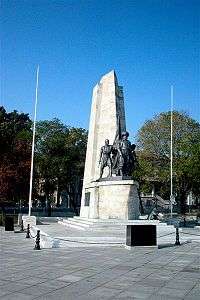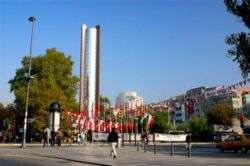Beşiktaş
| Beşiktaş Beşiktaş Belediyesi | |
|---|---|
| Municipality of Beşiktaş | |
|
Besiktas Square | |
 Location of Beşiktaş in Turkey | |
 Beşiktaş Location of Beşiktaş in Turkey | |
| Coordinates (Atatürk Statue, Beşiktaş Square): 41°4′10″N 29°1′40″E / 41.06944°N 29.02778°ECoordinates: 41°4′10″N 29°1′40″E / 41.06944°N 29.02778°E | |
| Country | Turkey |
| Province | Istanbul Province |
| Neighborhoods | |
| Government | |
| • Municipal president | Murat Hazinedar (CHP) |
| Area[1] | |
| • District | 21.33 km2 (8.24 sq mi) |
| Population (2012)[2] | |
| • District | 186,067 |
| • District density | 8,700/km2 (23,000/sq mi) |
| Website | www.besiktas.bel.tr |
Beşiktaş (pronounced [beˈʃictaʃ]) is a municipality (belediye) of Istanbul, Turkey, located on the European shore of the Bosphorus. It is bordered on the north by Sarıyer and Şişli, on the west by Kağıthane and Şişli, on the south by Beyoğlu, and on the east by the Bosphorus. Directly across the Bosphorus is the municipality of Üsküdar.
The Beşiktaş municipality includes a number of important sites along the European side of the Bosphorus, from Dolmabahçe Palace in the south to Bebek in the north. The municipality also includes many inland (and relatively expensive, upper-middle class) neighborhoods such as Levent and Etiler. Some of its other well-known neighborhoods include Yıldız, Kuruçeşme, Ortaköy, and Arnavutköy.
Beşiktaş' historic centre is Çarşı, which adjoins the small Abbasağa Park. The Barbaros Boulevard, which runs in south-north direction, is a major street serving as a feeder for the inner-city motorway ![]() on the Bosphorus Bridge, and terminating in Zincirlikuyu Junction, an important bus transport hub.
on the Bosphorus Bridge, and terminating in Zincirlikuyu Junction, an important bus transport hub.
Name
The words beşik taş means "cradle stone" in Turkish.
According to one story, there was a Byzantine church, where Beşiktaş now is, with the name Kounopetra, Greek for "stone cradle". The church was built to honor a relic, a stone reportedly taken from the stable in Bethlehem where Jesus was born. This stone was later removed to Hagia Sophia and disappeared during the Fourth Crusade, possibly to be sold in Europe's relics market.[3]
According to another story, a cleric from an Aya Menas (Saint Menas) Church where Beşiktaş now is returned from a pilgrimage to Jerusalem with a cradle-shaped stone used in the baptism of Jesus and placed it in the church.[4]
According to yet another story, the name is a corruption of beş taş, Turkish for "five stones", referring to stone pillars used for mooring ships in the time of Barbaros Hayreddin Pasha.[5]
History


The Bosphorus has been settled for a long time, and there are many places of historical interest in Beşiktaş. This stretch of the Bosphorus shore is somewhat sheltered from the strong northeasterly winds that bring storms to Istanbul, and thus it forms a good mooring place for ships.
In Byzantine times, the area was called Diplokionion, meaning "double pillar" in Greek.
In ancient times the villages on the Bosphorus shore were isolated communities in the forest that lined the water-side. The Bosphorus, however, was prominent in the history and mythology of the ancient Greeks, and villages like Beşiktaş would have had their place in traditional tales such as Jason and the Argonauts. In the Byzantine era churches and a monastery were built and the tradition of having a summer palace on the Bosphorus was begun by the Byzantines with their Ayios Mamas palace complex. The Bosphorus settlements however, being outside the city walls, were vulnerable to raiders from the Black Sea coasts and little of this architecture or the statuary that would have decorated it so gloriously has survived.
In the Ottoman period, once the emperors had established control of the Black Sea coasts the Ottoman navy was docked in the Bosphorus and the Bosphorus villages became safe and attractive again. One man in particular, the legendary sailor Barbarossa, built his palace and mosque in Beşiktaş, making it his home. By now Beşiktaş was an established Bosphorus crossing for caravans trading across Anatolia and along the Silk Road, and of course for the great Ottoman armies.
This coast was of course very attractive to the Ottoman rulers, who built hunting lodges and then great palaces in the area, and the Beşiktaş district contains some of the most important and attractive Ottoman buildings. The area was thus the scene of great intrigues of the late Ottoman period such as the dethronement of Sultan Abdülaziz at Dolmabahçe Palace in a coup in 1876, the announcement of the founding of the Ottoman parliament in 1908, and the deposing of Sultan Abdul Hamid II at Yıldız Palace in 1909.
Following the foundation of the Turkish Republic in 1923, the Ottoman ruling family was deported and the palaces and mansions along the coast were emptied out. Some were given to new government ministries, some used as schools and other public buildings, other were pulled down.
Today, it is widely accepted by the residents of the municipality that the most significant resident of Beşiktaş was Zübeyde Hanım, the mother of the Turkish national hero Mustafa Kemal Atatürk, who lived in the old quarter at the core of Beşiktaş municipality, literally right next to the then headquarters of the Beşiktaş J.K..[6]
Beşiktaş is also an important transport junction with ferries going to the Asian side and dozens of busses departing from there.
Besiktas J.K.

The neighborhood gives its name to Turkey's oldest sport club, Beşiktaş Jimnastik Kulübü (Beşiktaş Gymnastics Club), founded in 1903. The club's football team is one of the top three in Turkey and has won 14 Turkish Super League titles and participated five times (1997–98, 2000–01, 2003–04, 2007–08, 2008–09) in the UEFA Champions League. The club's 33,000-seat BJK İnönü Stadium was on the Bosphorus seafront southwest of the center of Beşiktaş, and on match days the area used to be very crowded with football fans.
The new stadium (Vodafone Arena) is currently under construction on the İnönü site and is scheduled to be completed by April 2015.
The football team wears black and white shirts and is nicknamed the Black Eagles. The club has earned notoriety for its faithful fans, who have broken volume records with 132 decibel cheers.[7][8]
Beşiktaş J.K. also has basketball, volleyball, and other sports teams.
BJK Akatlar Arena is the home of the basketball team.
Education
The high school Etiler Anadolu Lisesi is in Etiler, Beşiktaş.[9]
The Istanbul Japanese School is located in Etiler.[10]
International relations
Twin municipalities
References
- ↑ "Area of regions (including lakes), km²". Regional Statistics Database. Turkish Statistical Institute. 2002. Retrieved 2013-03-05.
- ↑ "Population of province/district centers and towns/villages by districts - 2012". Address Based Population Registration System (ABPRS) Database. Turkish Statistical Institute. Retrieved 2013-02-27.
- ↑ Stratton, Arthur (1972). Sinan: Biography of One of the World's Greatest Architects and a Portrait of the Golden Age of the Ottoman Empire. Macmillan Publishers. ISBN 0-333-02901-1.
- ↑ Hürel, Haldun (2008). Semtleri, Mahalleri, Caddeleri ve Sokakları A'dan Z'ye İstanbul'un Alfabetik Öyküsü. İkarus. ISBN 978-975-999-290-3. Page 82.
- ↑ Hürel, page 82.
- ↑ http://www.bjk.com.tr/en/haberler.php?h_no=1480
- ↑ UEFA: Pick of the week
- ↑ The Independent: Besiktas are proud of their stadium's record as the noisiest on the planet
- ↑ "Okulumuz Hakkında Etiler Anadolu Lisesi". T.C. MİLLÎ EĞİTİM BAKANLIĞI:. Retrieved on June 8, 2014. "Adres: Nisbetiye Caddesi Akmerkez Yanı, Etiler Beşiktaş"
- ↑ "学校紹介". (Archive) Istanbul Japanese School. Retrieved on January 2, 2014. "タンブリ アリ エフェンデイ ソカク NO.16 エチレル イスタンブル/Tanburi Ali Efendi Sokak NO.16 Etiler Istanbul Turkey"
External links
| Wikimedia Commons has media related to Beşiktaş. |
- District governor's official website (Turkish)
- District municipality's official website (Turkish)
- Beşiktaş gallery at Fotopedia

